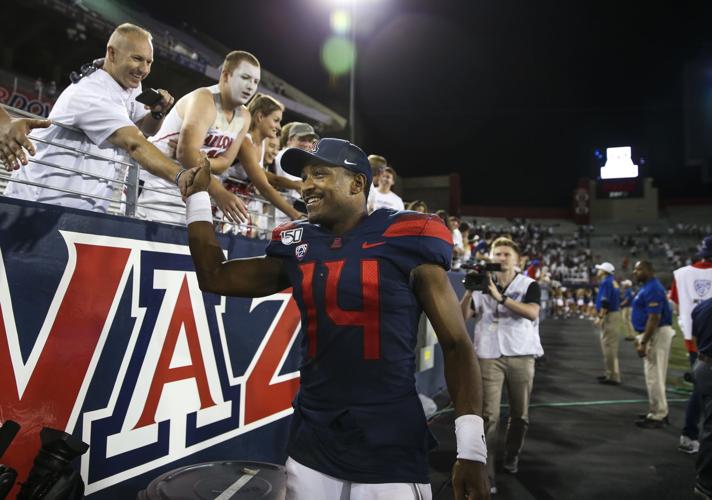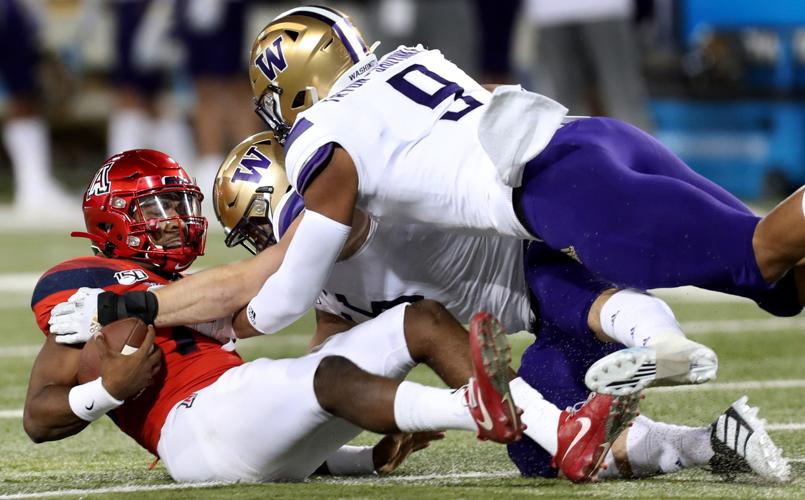This can’t be the end. Not like this. Not for Khalil Tate.
Tate’s story was supposed to play out differently. He was supposed to contend for the Heisman Trophy. He was supposed to get better under Kevin Sumlin. Tate’s senior season was supposed to finish triumphantly.
Instead, Tate faces the possibility of a premature exit from the spotlight. He struggled mightily the past two weeks and failed to finish either game. It’s fair to wonder how long that can go on. If Tate struggles again at Stanford on Saturday, and Sumlin pulls him again, will that be the last we see of one of the most prolific quarterbacks in UA history?
Statistically, Tate has far exceeded the accomplishments of his predecessors and former teammates. But Tate could succumb to the same fate as Anu Solomon and Brandon Dawkins. After extended runs as Arizona’s starting quarterback, neither finished his UA career in that capacity.
Solomon got banged up and yielded the job to Dawkins in 2016. Dawkins got hurt at Colorado in ’17 and got Wally Pipp-ed by Tate.
So began the most glorious month an Arizona quarterback ever has experienced — a run of success unprecedented across the Pac-12. Tate won the league’s Offensive Player of the Week award four straight times. It remains an unmatched achievement.
Many ups and downs followed. A coaching change. A cryptic tweet. Rampant transfer speculation. A new offensive system. An injury. Regression. Progress. Rebirth.
Now we’re in the latter stages of this Tale of Two Octobers. A month that began with such promise — a career passing day in Boulder, of all places — has deteriorated rapidly.
Tate committed two turnovers against Washington, including an inexplicable fumble that led directly to a Huskies touchdown, and looked lost against UW’s persistent pressure packages. Tate managed just 51 passing yards in two-plus quarters against USC, suffering almost as many sacks (six) as he completed throws (seven).
Most shocking of all, those sacks left Tate with minus-55 net rushing yards against the Huskies and Trojans. The same Tate – well, maybe not quite the same – who rushed for 1,207 yards over a six-game span in 2017.
How did we get here? How will Tate’s story end? Let’s take a closer look.
Under pressure
There’s no need to revisit everything that’s happened between October 2017 and October 2019. We’ve been over it all before. So let’s fast-forward to Oct. 12 of this year.
Washington, which hadn’t faced Arizona since Tate became the starting quarterback, came to Tucson for a #Pac12AfterDark matchup. Tate was coming off a performance at Colorado that represented a comeback in multiple ways: He helped the Wildcats rally from a fourth-quarter deficit. He also had returned to the lineup after missing the previous game because of injury.
Tate completed 31 of 41 passes for a career-high 404 yards with three touchdowns and one interception in a 35-30 win against the Buffaloes. Then the Huskies stymied him.
“When he had the opportunity in the pocket to calmly read coverages and deliver the ball, he was throwing it as well as at any point in his career,” said Pac-12 Networks analyst Anthony Herron, who broadcast the Arizona-USC game the following week and will be on the call at Stanford as well. “Washington said, ‘Let’s not let him do that.’”
The Huskies sent extra pass rushers at Tate, no matter the down or distance. They rushed inside linebackers and nickel backs. They forced Tate to make lightning-quick decisions – while at the same time limiting his ability to escape to the perimeter. It was an impressive combination of aggression and discipline.
Herron said Washington “didn’t necessarily crack the code” on Tate, but the Huskies provided a game plan that, if properly executed, stood a good chance of working.
Sure enough, USC employed a similar approach. Tate didn’t turn the ball over, but he couldn’t move the offense either. After scoring just three points with Tate at quarterback in the second half vs. the Huskies, the Wildcats got shut out in the first half against the Trojans. After an empty series to start the second, and with Arizona trailing 17-0, Sumlin replaced Tate with Grant Gunnell. The freshman played the rest of the way.
In his final appearance in his hometown of Los Angeles, Tate watched most of the second half from the bench. He placed a navy UA baseball cap atop his head, as veteran quarterbacks do. But he hadn’t played like one.
“I see a guy who’s not responding well to immediate pressure,” Herron said.
He’d like to see Tate “cut it loose” and “trust his eyes” — throw with a greater sense of anticipation instead of waiting for a receiver to clearly come open. That hasn’t been a consistent strength for Tate, even when he was playing well. But opponents have caught up to his fastball. He needs to develop a secondary pitch.
“Defensive coordinators got tape of Khalil and figured out where he likes to escape,” Herron said. “To me, you’re a vertical-escape guy or a lateral-escape guy. Khalil is a lateral-escape guy. He’s run himself into pressure. He’s run himself into sacks quite a bit.”
Now Tate is running out of time.
All good things …

In his last two games, Arizona’s Khalil Tate has a combined minus-55 net rushing yards. If he struggles again Saturday at Stanford, fans may not get to see much more of him on the field.
It’s important to note that Arizona’s offensive breakdowns the past two weeks aren’t solely the fault of the quarterback. The offensive line has struggled as well. Everyone shares some of the blame.
But Tate is the player who can swing the Wildcats’ fortunes more than any other. So it must be asked: Are his problems fixable? Or have we reached the he-is-what-he-is stage of his career?
“It’s certainly improvable,” Herron said.
He believes Sumlin and offensive coordinator Noel Mazzone can do more to help Tate and the offense recapture their mojo. Designed rollouts haven’t been a big part of Mazzone’s offense, but Herron thinks Tate would benefit from some “predetermined pocket movement,” which would enable him to “change the launch point.”
“Defenses right now are teeing off on Arizona’s pocket no matter who’s in there,” Herron said.
The former defensive lineman added that moving the pocket “takes the starch out of the pass rush” because defenders don’t always know where the quarterback will be standing.
Sumlin made his position on the quarterback situation clear soon after the USC game and repeated it later in the week. The plan, at least according to Sumlin, is to continue with the status quo: Tate No. 1, Gunnell No. 2.
Sumlin also stated that Gunnell wouldn’t redshirt this season. He has appeared in four games. One more, and the redshirt option is off the table.
It wouldn’t surprise anyone if Gunnell played in some capacity Saturday. Herron, who has talked extensively with Sumlin and Mazzone these past two weeks, had two takes on that:
No. 1: “I don’t believe that if they felt like Grant was the best option to win that they would hesitate to name him the starter. My impression is that they don’t feel that way yet.”
No. 2: “I don’t think if Grant gets reps, it will mean it’s the last we’ve seen of Khalil.”
Still, as always, all eyes will be on Tate and how Sumlin handles him. There has to be a limit on how many times he can change quarterbacks … right?
Saturday, Oct. 26, might be the expiration date for the Tate era. Or it might not.
They say all good things come to an end. They don’t tell you how or when.






